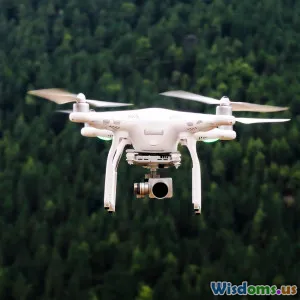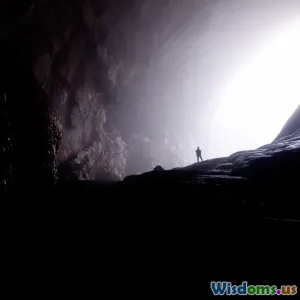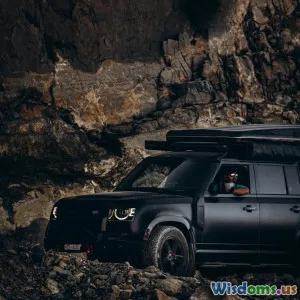
Are Drones Changing The Future Of Expedition Logistics
16 min read Explore how drones are revolutionizing expedition logistics with faster delivery, improved safety, and real-time data, transforming exploration in remote and challenging environments. (0 Reviews)
Are Drones Changing The Future Of Expedition Logistics?
The image of remote exploration—teams trudging through untamed wilderness, supplies strapped to backs and beasts, the whip of wind—that's fading. Drones have flown into the world of expedition logistics with such force that they're not just changing how goods are delivered; they're changing where, when, and even if some trips happen at all. As their whirring rotors echo above forests and glaciers, it begs the question: are drones rewriting the adventure rulebook for expeditions?
Trailblazing Remote Resupply: Shifting the Challenge Frontier

In 2019, a team ascending Mount Everest received a critical payload—medicines, oxygen, and recovery snacks—delivered not by helicopter, mule, or human runner, but by an autonomous drone. The event hardly made global headlines, but for many in the expedition community, it marked a seismic shift. Until recently, resupplying expeditions in hostile, isolated environments was fraught with risk and cost. Helicopter sorties were dangerous and expensive; human porters took time, energy, and exposed themselves to hazards.
Today, drones can fly resupply missions deep into jungles, up mountainsides, or across polar ice fields where landing a helicopter is impossible. In Antarctica, the British Antarctic Survey has used fixed-wing drones to deliver payloads to scientists perched on inaccessible glaciers, bringing them food and data-logging eqipment. Companies like Zipline deliver blood and medical supplies across treacherous Rwandan terrain in hours, bypassing flooded roads and impassable ravines—scaling solutions once unimaginable.
Expedition planners now regularly ask: can we cut air drops, animal caravans, or risky solo treks and rely on a drone fleet for everything from fuel samples to spare batteries and hot meals? The answer, increasingly, is yes.
Risk Reduction and Rescue: Drones on the Emergency Front Lines

What once took hours may now take minutes. In the high Alps, the Swiss search and rescue services test out drones that quickly locate lost climbers by thermal imaging and deliver first aid kits and survival blankets. Consider the 2023 Himalayan disaster, when an avalanche stranded trekkers: drones dispatched swift reconnaissance, beaming live aerial feeds to rescue command centers. Within minutes, thermal cameras spotted survivors’ heat signatures, pinpointing their location under meters of snow—in situations where every second saved can be the margin between life and death.
The improvement isn't just in search efficiency, but in payloads. Drone-based delivery systems are sophisticated enough to drop life-saving epinephrine, anti-venom, or communications devices with high precision. The Red Cross has trialed drones that drop two-way radios or even buoyancy equipment to climbers or kayakers trapped beyond traditional rescue range. The shift isn’t theoretical; it is life-changing on the bleeding edge, with drones saving time, reducing physical risk to rescuers, and even attempting automated evacuation with cargo-drones capable of transporting an injured person from danger.
Mapping, Surveying, and Intelligence in Real Time

Ask any expedition leader: the better your information, the better your chances of success. Before drones, teams relied on satellite imagery, maps, and occasionally, word-of-mouth. Drones now provide ultra-high-resolution, up-to-date visuals at the push of a button. Expeditions in the Amazon River basin—or remote cathedral canyons—send drones up for orthomosaic mapping, photogrammetry, and 3D-rendered terrain models. The difference? You see every rock, every tree gap, every possible riverside camp.
Nor are drones just passive surveyors. Mineral exploration teams and climate researchers use drones equipped with LIDAR, thermal, and multispectral sensors to detect underlying land composition, search for resource deposits, monitor ice flows, and track animal migrations—all in one autonomous sweep. What might have taken teams weeks with boots on the ground now occurs in a matter of flights, with accuracy rates that rival manned helicopters, at a fraction of the cost.
The democratization of intelligence gathering lowers the entry barriers for expeditions everywhere. Students from community colleges launch mapping missions in Patagonia right alongside national geographic societies, shrinking the expertise gap and boosting the collective knowledge of the unexplored world.
Breaking Weight and Range Limits: The Rise of Hybrid Drones

Early drones suffered from severe payload and battery limitations, barely able to carry a GoPro or first-aid pack. Fast-forward, and the latest VTOL (vertical takeoff and landing) or hybrid drones can haul over 25 kilograms and stay airborne for more than eight hours—a feat previously reserved for small aircraft.
Take the Skyfront Perimeter drone, which can deliver 10 kg loads across New Zealand’s wilds with a 100km range, operating on a hybrid gas-electric system that greatly extends mission durations. Adventure tourism companies use heavy-lift drones to pre-stage mountaineering basecamps and air-drop kayaks or bicycles into unexplored terrain. Conservation bodies use them to silently release seed pods across vast, inaccessible reforestation areas, increasing efficiency with less environmental impact than traditional drop-offs.
This heavy-lift capability is not just about more cargo; it's about radically new workflows. Emergency beacons, mobile power generators, and even temporary shelters can be airlifted and precisely delivered. Expeditions are getting lighter because their logistics are heavier—in the air, not on human backs.
Autonomous Fleets: The Dawn of Swarm Logistics

It’s not just one drone overhead—imagine dozens acting in smooth concert. The future is autonomous fleets or “drone swarms” managed by powerful AI, each assigned tasks for seamless, persistent operations. Consider mountain rescue missions: an AI drone fleet automatically scans for avalanche survivors by grid, drops warming packs, updates the command center, and reapportions drones to new zones based on live data.
Tested first in military environments, swarm logistics is trickling into civilian expeditions. In Norway's Svalbard archipelago, researchers trial distributed fleets to measure and respond to unpredictable Arctic melt events. When supplies need to leapfrog across obstacles—rivers, broken bridges, ice cracks—a swarm can transport meal packs, fiber optic cables, or solar chargers separatley, then regroup at the target site, ensuring resilience against drone loss or weather complications.
With sensor-to-sensor fusion and autonomous tasking, expeditions now run on real-time logistics loops. Gone are the days of daily rendezvous for food caches—swarm-team deliveries can be instantly adjusted to shifting team timelines and hazard levels.
Challenges: Regulation, Weather, and the Human Factor

Yet, expeditions must still negotiate obstacles. National airspace regulations, especially across international borders or protected areas, are a complex thicket. In Nepal, prior drone missions required special permits, which could slow response during acute emergencies. Permission for night operations, vital for med-evac or anti-poaching, may conflict with both regulatory and ethical standards.
Weather, always the expedition's daunting adversary, can ground even state-of-the-art drones. Freezing rain, arctic drift, rapid changes in wind speed all challenge drone reliability. Bird strikes, battery failure on cold glaciers, or GPS signal loss in dense jungle remain real risks, requiring contingencies. Proper pilot training, spare hardware, and fail-safes matter almost as much as the drone hardware itself.
And then there’s the human dimension: expedition psychology. Relying on machines for basic survival can alter a team’s mindset, for better (less weight, fewer injuries) and worse (complacency, tech overdependence). The best teams combine drone innovation with classic expedition skills so they remain self-sufficient if the tech fails.
Case Studies: Expeditions Transformed

The Siberian Crossing – Medical Aid Beyond Roads
In 2022, a biology team traversing Russia’s Putorana Plateau—hundreds of miles beyond the last village—faced a medical crisis: severe hypothermia and a suspected infection. A quadcopter dispatched from the nearest river outpost—180 kilometers away—successfully delivered antibiotics and infrared heating packs, keeping the scientist alive until evacuation became possible.
Karst Caves in Borneo – Impossible by Foot
Explorers mapping Borneo’s sprawling underground river systems faced narrow gorges and impossible climb-downs. Modular drones were modified to drop biodegradable bread-crumb sensors and relay Wi-Fi repeaters within collapsed tunnels, creating a digital map no one could have done so quickly or safely by hand.
Antarctic Glaciology – Fast Eyes in the Ice
Glaciologists tracking break-up events piloted drones as sky sentinels, alerting their snowcat convoy of dangerous crevasses and delivering replacement radar gear directly to positions previously unreachable without a risky field traverse.
These cases illustrate not only problem-solving but enabled entirely new research and interaction with the wilderness.
Getting Started: Key Tips for Drone-based Expedition Logistics

Thinking of integrating drones into your next major trip? Here are key actionable steps for expedition planners:
- Understand Local Laws: Map airspace and permit requirements for each country or territory in your route. Contact authorities in advance; factor in time for reviews and compliance paperwork.
- Assess Payload and Flight Durations: Choose drones with sufficient lift and range for planned missions. Battery heaters and swappable cells help in cold, remote areas.
- Multi-sensor Planning: Equip drones with modular mounts to switch between payload types—medical, survey, or communication—to cover evolving needs.
- Redundancy First: Carry spares for motors, props, and batteries. Plan mission critical deliveries with two (or more) drones in case of technical hiccups.
- Technical Training: Invest in pilot skills for both manual and autonomous operations. Teams should run simulation drills that include loss-of-signal and hard weather cases.
- Power Strategies: Bring flexible solar panels or lightweight generators to recharge on the move. Plan for worst-case battery lifespans factoring in environmental de-rating.
- Ethics and Environment: Minimize noise and animal disturbance; do not use drones to harass wildlife or enter indigenous sacred sites. Obtain permission and engage local communities.
The Horizon: What’s Next for Drone-empowered Expeditions?

Looking forward, technology will further tilt the field. Hydrogen fuel cells and perovskite solar film could keep drones aloft for days, not hours. Swarming logic may enable persistent presence in the wild, with autonomous airborne warehouses staged above teams for instant deliveries. The rise of satellite-linked drones erases the traditional communications blackout, making even the farthest reaches of Amazonia, the Arctic, or Saharan dunes accessible and safe.
Expeditions are about pushing limits—physical, mental, and now, technological. Drones unlock supply chains and data pipelines in ways that democratize access, protect teams, and shrink logistical barriers to near-imaginary proportions.
With the buzz above and innovation below, drones are not simply flying alongside explorers—they’re carrying expeditions into a wild future once closed to all but a few.
Rate the Post
User Reviews
Other posts in Expedition Planning
Popular Posts














